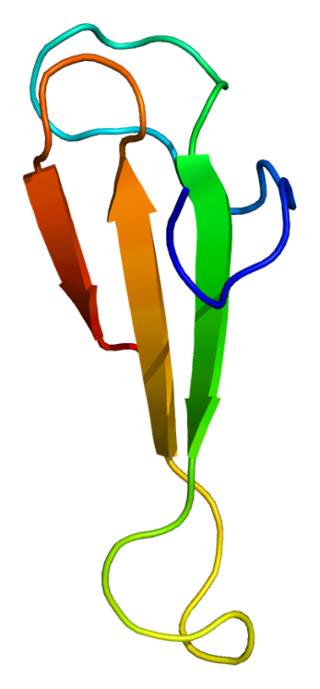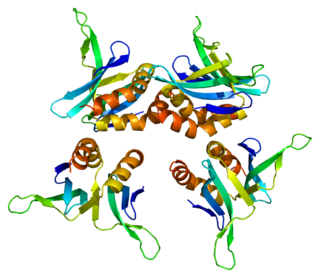
RNA polymerase II is a multiprotein complex that transcribes DNA into precursors of messenger RNA (mRNA) and most small nuclear RNA (snRNA) and microRNA. It is one of the three RNAP enzymes found in the nucleus of eukaryotic cells. A 550 kDa complex of 12 subunits, RNAP II is the most studied type of RNA polymerase. A wide range of transcription factors are required for it to bind to upstream gene promoters and begin transcription.

The TATA-binding protein (TBP) is a general transcription factor that binds to a DNA sequence called the TATA box. This DNA sequence is found about 30 base pairs upstream of the transcription start site in some eukaryotic gene promoters.
Transcription factor II D (TFIID) is one of several general transcription factors that make up the RNA polymerase II preinitiation complex. RNA polymerase II holoenzyme is a form of eukaryotic RNA polymerase II that is recruited to the promoters of protein-coding genes in living cells. It consists of RNA polymerase II, a subset of general transcription factors, and regulatory proteins known as SRB proteins. Before the start of transcription, the transcription Factor II D (TFIID) complex binds to the core promoter DNA of the gene through specific recognition of promoter sequence motifs, including the TATA box, Initiator, Downstream Promoter, Motif Ten, or Downstream Regulatory elements.

Roger David Kornberg is an American biochemist and professor of structural biology at Stanford University School of Medicine. Kornberg was awarded the Nobel Prize in Chemistry in 2006 for his studies of the process by which genetic information from DNA is copied to RNA, "the molecular basis of eukaryotic transcription."

Eukaryotic transcription is the elaborate process that eukaryotic cells use to copy genetic information stored in DNA into units of transportable complementary RNA replica. Gene transcription occurs in both eukaryotic and prokaryotic cells. Unlike prokaryotic RNA polymerase that initiates the transcription of all different types of RNA, RNA polymerase in eukaryotes comes in three variations, each translating a different type of gene. A eukaryotic cell has a nucleus that separates the processes of transcription and translation. Eukaryotic transcription occurs within the nucleus where DNA is packaged into nucleosomes and higher order chromatin structures. The complexity of the eukaryotic genome necessitates a great variety and complexity of gene expression control.

Transcription initiation factor TFIID subunit 6 is a protein that in humans is encoded by the TAF6 gene.

Transcription initiation factor TFIID subunit 1, also known as transcription initiation factor TFIID 250 kDa subunit (TAFII-250) or TBP-associated factor 250 kDa (p250), is a protein that in humans is encoded by the TAF1 gene.

Mediator of RNA polymerase II transcription subunit 1 also known as DRIP205 or Trap220 is a subunit of the Mediator complex and is a protein that in humans is encoded by the MED1 gene. MED1 functions as a nuclear receptor coactivator.

TAF9 RNA polymerase II, TATA box binding protein (TBP)-associated factor, 32kDa, also known as TAF9, is a protein that in humans is encoded by the TAF9 gene.

Transcription elongation factor A protein 1 is a protein that in humans is encoded by the TCEA1 gene.

Activated RNA polymerase II transcriptional coactivator p15 also known as positive cofactor 4 (PC4) or SUB1 homolog is a protein that in humans is encoded by the SUB1 gene. The human SUB1 gene is named after an orthologous gene in yeast.

Cell division protein kinase 8 is an enzyme that in humans is encoded by the CDK8 gene.

Transcription initiation factor TFIID subunit 10 is a protein that in humans is encoded by the TAF10 gene.

Transcription initiation factor TFIID subunit 5 is a protein that in humans is encoded by the TAF5 gene.

Mediator of RNA polymerase II transcription subunit 24 is an enzyme that in humans is encoded by the MED24 gene.

Transcription factor IIIA is a protein that in humans is encoded by the GTF3A gene.

Mediator of RNA polymerase II transcription subunit 17 is an enzyme that in humans is encoded by the MED17 gene.

TAF6-like RNA polymerase II p300/CBP-associated factor-associated factor 65 kDa subunit 6L is an enzyme that in humans is encoded by the TAF6L gene.

General transcription factor IIF subunit 1 is a protein that in humans is encoded by the GTF2F1 gene.
The transactivation domain or trans-activating domain (TAD) is a transcription factor scaffold domain which contains binding sites for other proteins such as transcription coregulators. These binding sites are frequently referred to as activation functions (AFs). TADs are named after their amino acid composition. These amino acids are either essential for the activity or simply the most abundant in the TAD. Transactivation by the Gal4 transcription factor is mediated by acidic amino acids, whereas hydrophobic residues in Gcn4 play a similar role. Hence, the TADs in Gal4 and Gcn4 are referred to as acidic or hydrophobic, respectively.















